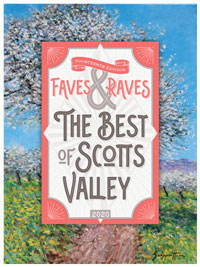
As she peered down through the water at the south end of Loch Lomond, inveterate kayaker Alecia Morgan spied something big, round and white. Maneuvering her boat around, she slipped her paddle down three feet into the sandy shoreline and picked up a Canada goose egg,
Morgan saw a tiny hole, and as she peered in, she saw something wiggling inside. Thinking it must be a bird, she began peeling the hole open — and out popped a crawfish.
“It must have entered when it was small, grew, and then it couldn’t get out,” the Lompico resident theorized.
When she set the egg on a stump and helped the crayfish out of the egg, it promptly scooted back into its watery home.
When the wind is calm, Morgan spends seven to nine hours on the lake.
First she skirt along the edges looking for “things that shouldn’t be there — fishing lines and hooks and garbage,” which she picks up with her paddle and deposits back on shore.
“The first time I saw a bird flying over the lake with a fishing line hanging out of his rear, I said, ‘That’s going to be one of my goals.’ Everyone who sees that stuff should take it down or tell a ranger.”
Then she kayaks back into the water to find peace where she can “meditate, look, listen, and learn.”
Using this mantra, she has explored the tree-shrouded lake and its inhabitants for the past five years, shooting thousands of photos.
Most animals are shy, like the endangered western pond turtle, and she rarely gets to see one — she only hears the splash.
“But one turtle will pose half-heartedly,” Morgan said.
Sadly, one day she found a dead turtle, named A.J. When rangers performed a necropsy, they discovered he was 50 years old.
Morgan has created a book that children could use to walk around with their parents and try to find things pictured in the book, like trees and baby fish. Unfortunately, she has been unable to find funding for publication.
In the future, she hopes to see “more individual-friendly boats, instead of the big metal boats that are hard to maneuver for one person. Paddleboats are only good if you have strong knees.”
Authorities at Loch Lomond have begun meetings with the community to discuss what they envision for the future of the reservoir.
On July 7, I invite community members to take an environmental walk, sponsored by the San Lorenzo Valley Water District, with Scot Lang, chief ranger at Loch Lomond; Chris Berry, watershed compliance manager at the city of Santa Cruz; and Morgan.
Berry and Lang will share the nearly finalized habitat conservation plan for anadromous salmonids, the western pond turtle and other species.
We will find out why new strategies for steelhead and salmon will begin to lower water levels at the lake, discover how we can start thinking like a watershed manager and answer the question, Where does the San Lorenzo River watershed start and where does it end?
“Looking at new activities, boating is the top issue that people want to see improved,” Berry said. “We noticed a severe decline when we banned outside boats.”
That action was taken to keep exotic mussels from invading the lake and clogging water pipes.
“We need to make Loch Lomond more welcoming to outsiders,” Berry said. “We need a better inspection program. If we’re relying on personal inspection to keep invasive species out of the lake, we’re probably destined to have exotic species.”
Better inspection strategies might mean that people could take their boats to the lake again.
Several weeks ago, Berry saw a child who carried a bucket full of exotic minnows and water into the reservoir grounds.
“Who knows where it all came from? I just about had a heart attack,” he said. “The potential threat from that one action is higher than boats coming in.”
He and Lang will share more of the draft report with us, like launching new programs for rental canoes and kayaks with safety classes and fines for “convenient capsizing events,” as Berry calls them, during hot days.
On the walk, we will discuss other possibilities, such as docent-led ranger hikes.
“We might be able to open up formerly off-limit land with historic areas and view points,” Berry said.
The final plan will be approved by the Santa Cruz City Council by next summer.
He will also share a new phone application, Creekwatch, through which locals can input observations of creeks and upload them to a server that tracks the data.
If you would like to join this free walk, contact me at ca****@*********on.com.
For a video on western pond turtles, visit http://www.youtube.com/watch?v=hPYrCvqdsRU&feature=youtube
– Carol Carson, M.Ed., is a naturalist, writer and educator.











